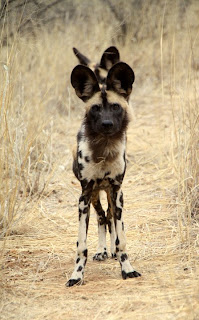This weeks theme is 'Rocks'. Interpret that any way you can and join the fun!
There is a wall in Namibia: well, there are quite a few actually, but this wall is a very special wall - it's a work of art! Not many people have seen or heard of this artistic wall: they wouldn't have, it's just been built. Built by a group of volunteers from USA, Canada, Germany, UK, Namibia, and myself from New Zealand. We volunteers, who care about elephants, gave up our spare time, paid out big money on airfares and volunteer fees, sweated in the hot sun, got filthy, went unshowered for a week, and were sleepless while some farmer's jackass was getting it off all night with with all those happy jennys! All night long! heehaw, heehaw, heeeeehaaaaw. How could he?
Why Build a wall?

Why on earth would anyone want to travel halfway around the world to build a wall in Namibia? Who would bother?
Well, lots of people do. Every year 100's of volunteers of all ages, head to Namibia's Damaraland to devote their time and effort to
Elephant-Human Relations Aid, EHRA and their desert elephant conservation efforts. Elephants seeking water from farm or village water points will often break down tanks, or pumping equipment - even ripping pipework out of the ground. EHRA recognised the need for rock wall protection to prevent damage. Simple and effective: walls built just high enough for an elephant to get their trunk in, but stop them breaking or turning over the tank. A drink of water, and the small herd can go on their way. A complimentary program is also run to educate the community to value the desert elephants as being unique and attracting tourists, thereby creating job opportunities. Wildlife conservation can only be effective if local communities can be fully involved with them reaping benefits also.
In August 2008 I joined a team and we built a wall just south of the C35 road Ugab River crossing.
 |
| August 2008 at EHRA. |
Do locals want walls?
Kay and I re-visited Namibia in 2009 and we visited much of the area I was in with EHRA the previous year. I drove into the small native community causing a bit of consternation with the locals. But we found a young man who spoke English and he asked why we were there. I held out a small photo album and presented it to him, asking if he knew the local man who is smiling in the front of the above picture smiling behind the two women.
"Oh yes, I know that man."
"Will you please give him this book of photos?"
With that, he beamed and I showed him myself standing in the photo and said I helped build the wall behind him.
"It is a beautiful wall. We love this wall! No elephant damage."
We were made welcome by the families but had to be on our way. That little photo album may become a prize possession in a little hut with not much else in it.
That sounds like that community is pretty happy with EHRA, and the work the volunteers do.
 |
| Our first day's effort. |
Why volunteers?
For locals to build a wall requires money: they just don't have it.
Easier for them to shoot the elephants.
Going back to Namibia and EHRA in May this year was different than the first: I knew what was expected. Plus this time I was going with eyes wide open scrutinising every little flower, insect, lizard, and up early for the sunrises and sunsets with camera working overtime. The elephants were just a bonus! The difference in the country between the August 2008 dry season and the late rains of this year into May, was remarkable. Wildflowers everywhere, insect life buzzing, lizards scuttling away at every step; it was a very beautiful time to see the country.
Cooler weather meant building our wall was much less stressing. We made good time. The girls - some who had signed on for several weeks - really got into it, dressing our wall with sparkly chunks of white or green quartzite. Crystals of quartz delicately mortared into the wall glittered in the sun. Namibia is an ancient land, rich geologically, and valley floors are covered in quartz and marble fragments, and other semi-precious stones. It is a geologists or
gem hunters paradise.
 |
| Our gang. |
The Great Bling Wall of Namibia.
Our wall became the Great Bling Wall of Namibia. Not just a wall but a work of art.
It's the only one of its kind. Not just made from rocks of granite or marble - but bling. Those crazy girls!
I wonder whether elephants will be so blinded by the glare they'll walk right into our wall and knock the whole lot over?
1. Paste the link to your post, and your name in the box below.
2. And leave a comment please, we really want to know you are enjoying this!
3. And to help your post's readers find every one's articles easily, paste the url to this week's post into a link in your article, with a sentence something like this -
"I'm sharing my Magnificent Monday post here (MM Link goes here) . Pop in, join in or just follow the links to other great stories and pics!"
4. Visit each post over the week and leave a comment




















